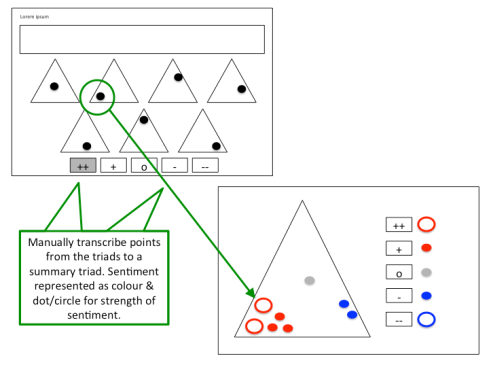I have been a fan of cognitive-edge technology and techniques for many years. Myself and a small group have been engaged in exapting sensemaker for use on Agile Projects. I did my Sensemaker training with Tony Quinlan. Tony subsequently delivered a fantastic introduction to Sensemaker at QCon which is the material I use when introducing it.
Sensemaker is a fantastic and valuable tool, though its usage in Agile transformations and projects is different to its original context. I will share my experience using the standard report format namely:
- What is the context?
- What did you try?
- What worked?
- What did not work?
- What have you learned?
Context for using Sensemaker
In all three cases, there was a situation with a lot of uncertainty and the leaders showed great strength by trying something new.
- In the first example, a leader heard about sensemaker and very bravely decided to use it to get unstructured 360 feedback from a large group of people.
- In the second example, the team had scored “poorly” on one question on a company wide survey and the leaders wanted to understand why.
- In the third example, the leader for an Agile transformation (two thousand people) wanted a survey to understand how people in the department felt about the transformation. A pilot with fifty people was run to test the process.
It was only because I had run the first two fairly small sensemaker exercises that I had the confidence to run the much larger (and personally risky) third exercise.
What we did
In all three cases, the leader sent an e:mail out setting the context for the survey and asking for the team to participate. The sensemaker survey they were asked to fill in was a slide in a powerpoint presentation. In the first example, the survey was also printed and handed out in a team town hall. In each case, the leader introduced the sensemaker survey in the townhall or extended leadership meetings.
The responses were all anonymous. In some locations a “post box” was created for the team to post their response. In some locations, team members would send their response to a trusted colleague who would forward them to the person collating the results. Many people felt comfortable enough just to send a response directly.
Unlike the sensemaker method which starts the signifier creation process with a literature search, the triad signifiers were created using terms commonly used in the environment. For the 360 degree feedback, the leader incorporate the six headings in the corporate leadership assessment. For the Agile transformation, phrases common to agile and software development were used (Technical Debt, Architecture, Deadline, Business, Leadership, Culture, Mastery, Autonomy, Purpose, Business Value).
The results were collated manually. Each dot on a completed survey was collated onto a large triad, one per powerpoint page.

The sentiment (positive, negative, neutral) was depicted using colour (red, grey, blue respectively) and strength of sentiment ( normal, very) by shape (dot, circle). Red / Blue was chosen as traditional red/amber/green are difficult to differentiate for those with colour blindness which is common in technology.
The results were summarised. The summary and original survey sheets (or scans of physical paper) were included as an appendix to the summary. The individual stories were ordered by sentiment, and a hyperlink was placed on each summary diagram to the first story of each sentiment to speed up finding the stories.
The results were played back to the leadership team and then to the participants and the wider group. Each was invited to interpret the summary triads for themselves for before discussing them, and to read the stories associated with each cluster.
What worked
Sensemaker works! It provides useful and actionable insights.
One of the key experiences is that sensemaker shows you what people are not telling stories about. The gaps are as telling as the positive or negative clusters. For the first example, the leader was a very accomplished practitioner in the technology, however their other abilities outshone their technical skills. Armed with this knowledge, they were able to “create more stories about their technical abilities”.
One of the most powerful aspects of Sensemaker were the conversations that the exercise prompted each time. It provided a focus for some very difficult conversations that were based on data points (stories) rather than opinion. It enabled the group to make sense out of situations. Many of the things that Sensemaker revealed were already known, however they were difficult to discuss as opinions without “Hippos” closing down the discussion. Getting data to support a hypothesis with a traditional likert scale survey would have been politically unacceptable however the Sensemaker reveals the data without conflict. Once revealed, the stories can be discussed.
When you do a Sensemaker exercise you realise how beautifully it fits with the Cynefin framework. Discussions easily reveal things that are obvious or have multiple hypotheses. Sometimes, the discussions reveal it is necessary to dig deeper or bring in an expert. There were also stories that simply require action without understanding. Sensemaker helped us shape the transformation and resulted in several specific changes.
The three exercises only involved a few dozen stories rather than the massive number of stories that Dave Snowden and Tony Quinlan describe. Even though they numbered a few stories, they still provided valuable insights. Sensemaker works on the small scale as well as the large scale. Within organisations, culture tends to be determined at the tribe level (dunbar number of one hundred and fifty or less) with a dominant individual or group of individuals defining the culture.
Starting small helped me learn about Sensemaker. The first sensemaker exercise was small and fairly low risk. The experience at this level gave me the confidence and case study to refer to for the riskier second exercise. My experience with the first two exercises exercises helped me better understand the issues and provided me with stories that enabled me to convince the leaders for the third exercise. Starting small was safer for the leadership team and let them experience the approach before they tried it on a wider group outside of their area of control. My main practical advice would be start small and grow.
The leadership team said they would like rerun the Sensemaker exercise on a regular basis to track the progress of sentiment in the team.
What did not work.
Although the manual exercise was incredibly useful and valuable, reviewing the results was clunky and required a lot of effort. The manual approach is certainly limited in terms of scale. Above one hundred stories, it is likely that it would start to fail, and it would be necessary to use Cognitive Edge’s sensemaker tool. Ideally I would have preferred to use Cognitive Edge’s sensemaker tool but unfortunately that requires spending money. Spending money is the one thing that managers in large organisations do not like to do. The hope is that sharing the experiences with executives will lead to them to freeing up the funding for larger exercises. This is particularly difficult in an environment where people are used to getting their software for free (open source).
Although the results were insightful and valuable, we got stories from significantly less than half the people asked to participate. I worry that we got the “CYNics”(1) who cared but there is a large silent majority who have a different set of stories and opinions. I suspect the cognitive edge software would help with this.
(1) See the Dave Snowden’s references to cynics.
What did we learn
Sensemaker is a great tool to provide insights into your organisation when you are planning or engaged in an Agile transformation.
The normal Sensemaker approach (e.g. Literature search for signifiers) isn’t necessarily needed when the language of the culture is already well understood.
Sensemaker facilitates difficult conversations and is useful even if “no one learns anything from it”.
Even though Sensemaker and Cynefin are valuable when used individually, they are even more powerful when used together.
Next Steps
The Sensemaker and Scaled Agile Practitioner Community need to do more work together to better refine and exapt Sensemaker and Cynefin usage in the Agile Community. A summit focused on the use of Sensemaker in the initiation and monitoring of Agile Transformations would be very valuable. In particular, packaging Sensemaker with Dan Mezick’s Open Space Agility.


